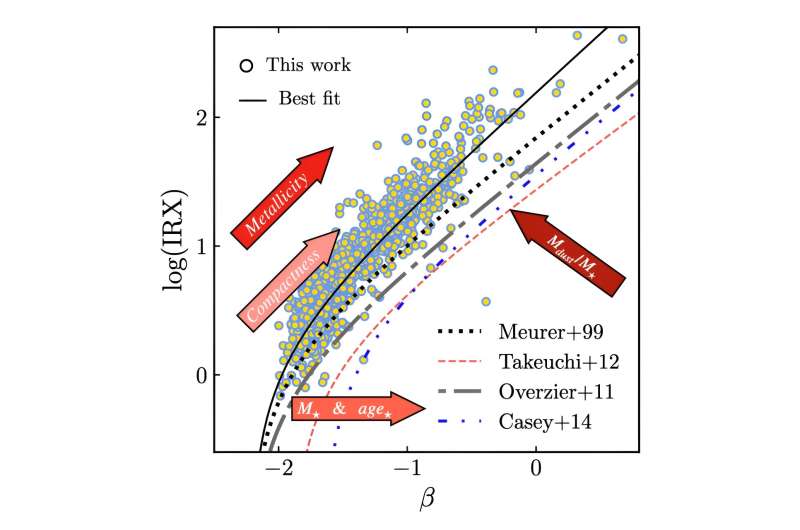This article has been reviewed according to Science X's editorial process and policies. Editors have highlighted the following attributes while ensuring the content's credibility:
fact-checked
peer-reviewed publication
proofread
Midlife crisis of the universe: Research finds galaxies' interactions did not affect interstellar dust

Dust is the most vital organ in galaxies. It absorbs and scatters stellar light, a phenomenon that is referred to as dust attenuation. On the other hand, dust emits this absorbed radiation thermally in the infrared. Normally, dust emits a similar amount of energy as it was absorbed from stars. This relation between dust absorption and emission, is called the energy balance.
A team of astrophysicists, led by Dr. Mahmoud Hamed from the National Center for Nuclear Research and his collaborators, mainly Dr. hab. Katarzyna Małek, has undertaken a comprehensive investigation into the dust-related energy budget of more than 1,000 galaxies. The paper is published in the journal Astronomy & Astrophysics.
This energy balance is characterized by the amount of light absorbed by dust and re-emitted thermally in the infrared. The amount of light absorbed by dust is characterized by the ultraviolet slope. The amount of energy emitted is characterized by the infrared excess, or the ratio between the infrared and the ultraviolet luminosities.
In this study Hamed analyzed a large sample of galaxies, and delved into the different properties of galaxies affected by the dust attenuation phenomenon. All studied galaxies are located at a distance of 7 billion years ago. It means that the team examined them as they were at a time when the universe was halfway through its life to date.
The authors found that metallicity, that is the abundance ratio of oxygen with respect to the more common hydrogen, strongly correlates with the dust-related energy balance of galaxies. In other words, the more interstellar dust absorbs stellar light, the higher the infrared emission, and the higher is the metallicity.
Additionally, a novelty of this work is the investigation of the relation between the energy balance and the compactness of galaxies. The authors also found a strong correlation between dust attenuation and the compactness of galaxies, which also validates previous recent findings from the same astrophysics department at the NCBJ.
Perhaps one of the most important results of this publication is the absence of any correlation between the role of the environment that galaxies reside in and the amount of dust attenuation. This is an unusual observation, because the environments of galaxies affect the key physical properties, such as the star formation, and the mass of galaxies.
Although this result is surprising, the authors in the next step aim to investigate the role of the environment when the universe was even younger, and for even dustier star-forming galaxies.
More information: M. Hamed et al, Decoding the IRX–β dust attenuation relation in star-forming galaxies at intermediate redshift, Astronomy & Astrophysics (2023). DOI: 10.1051/0004-6361/202346976
Journal information: Astronomy & Astrophysics
Provided by NCBJ





















